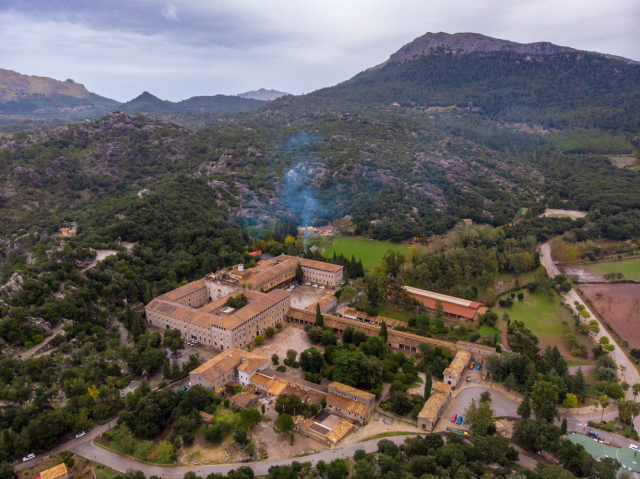The Camino de Santiago of Mallorca: the route that starts in the Balearic Islands
The Camino de Santiago de Mallorca is a Jacobean route that starts at the Sanctuary of Lluc in Escorca and ends in Palma, where it links directly with the Camino de la Lana.
What is the Camino de Santiago of Mallorca?
The pilgrimage to Santiago de Compostela can be started from different points of Spain, and there is an atypical route that requires crossing several kilometers of the Mediterranean Sea. The Camino de Santiago de Mallorca is a Jacobean route that starts at the Sanctuary of Lluc in Escorca and ends in Palma, where it links directly with Denia.
Once you cross the Mediterranean by boat and disembark at the Naviera Maritime Station located in the town of Alicante, pilgrims can seal the stage and look for the first stretch of the Camino de la Lana to find the lands of Santiago de Compostela.
Although it is not as famous as other Jacobean routes, it has become increasingly popular as it offers unique experiences to pilgrims starting their journey from Mallorca. Throughout the journey, different points of the island are crossed, offering the possibility of passing through picturesque sanctuaries where you can enjoy breathtaking views.
Why choose the Camino de Santiago of Mallorca?
The Camino de Santiago of Mallorca starts from the Sanctuary of Lluc, a monastery in the municipality of Escorca, located in the middle of the Tramuntana mountain range, at an altitude of 400 meters above sea level. The virgin of Lluc, patron saint par excellence of Mallorca, resides there and is considered one of the most sacred places of pilgrimage on the island. In addition, it has a botanical garden that gathers more than 200 varieties of plants of the Balearic Islands, so the starting point will make us feel part of nature from the first minute.
Being one of the ideal starting points for many hiking and cycling excursions, the Camino Viejo de Lluc is another favorite. It is a route full of history, dedication and miracles, which is why at the end of the 14th century up to seven stone crosses were erected representing the seven wonders of the virgin and patron saint of Mallorca. The road, which has been welcoming thousands of people since the Middle Ages, begins in Caimari, a small Mallorcan town where you can undoubtedly enjoy beautiful landscapes.
The Camino de Santiago de Mallorca allows you to break away from everyday activities and to fully appreciate some of the best views of the island, as well as some monasteries and an enormous diversity of plant species of great aesthetic and urbanistic interest. Crossing the island from one point to another, it is one of the ideal routes to connect with nature and start the pilgrimage to Santiago de Compostela.
Stages of the Camino de Santiago of Mallorca
It is perfect to start the journey from the Sanctuary of Lluc due to its historical and religious background, but the Camino de Santiago of Mallorca can be done from different points of the island. It is for this reason that there are many organizations that plan all kinds of excursions to reach the Estación Marítima de la Naviera in Palma and thus go by boat to the coast of the peninsula.
With more than 60 kilometers of route, the route from the Sanctuary of Lluc could be divided into four different stages. After crossing the Mediterranean Sea we can embark at the port of Valencia or Alicante to look for the first stretch of the Camino de la Lana that links with the French Way.
- Stage 1: Santuari de Lluc - Caimari (18 km)
- Stage 2: Caimari - Lloseta (18 km)
- Stage 3: Lloseta - Santa María del Camino (15 km)
- Stage 4: Santa María del Camino - Palma (15 km)
Routes
Blog
 ¿Vas a hacer el camino de Santiago? Cuida tus pies antes y después
¿Vas a hacer el camino de Santiago? Cuida tus pies antes y después
 5 razones por las que contratar un seguro de viajes
5 razones por las que contratar un seguro de viajes
 Formas de hacer un logotipo
Formas de hacer un logotipo
 La importancia del registro de llamadas durante tu viaje por el Camino de Santiago
La importancia del registro de llamadas durante tu viaje por el Camino de Santiago
Information
Points of interest
Cities & Towns | Hostels | Lodgings | Restaurants | Saddlery | Doctors | Points of interest | Bikes workshop
Contact us | Privacy policy | Cookies policy | | Terms of use | Authorship | Web Map | Consentimiento
© Copyright LA VOZ DE GALICIA S.A. Polígono de Sabón, Arteixo, A CORUÑA (ESPAÑA) Inscrita en el Registro Mercantil de A Coruña en el Tomo 2438 del Archivo, Sección General, a los folios 91 y siguientes, hoja C-2141. CIF: A-15000649
